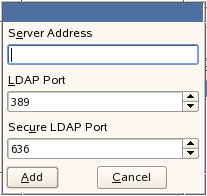5.4 Upgrading to OES 2 SP3
Use the following instructions to complete the upgrade applicable to the installation source you are using:
-
Section 5.4.1, For Servers with EVMS and NSS on the System Device
-
Section 5.4.2, To Upgrade Using a Network Installation Source with DHCP (Offline)
-
Section 5.4.3, Upgrading Using a Network Installation Source without DHCP (Offline)
-
Section 5.4.8, Specifying the Add-On Product Installation Information
-
Section 5.4.9, Reviewing the Delete Unmaintained Packages Notification
-
Section 5.4.10, Verifying and Customizing the Update Options in Installation Settings
5.4.1 For Servers with EVMS and NSS on the System Device
NOTE:This section doesn’t apply if you are upgrading through the patch channel as explained in Using the Patch Channel to Upgrade (Online).
If you are upgrading a server that has EVMS as the volume manager for the system device, you need to enable boot.lvm and boot.md. (The system device contains the /boot, swap, and / (root) partitions) and might also have Novell Storage Services (NSS) pools and volumes.)
Do the following just before you begin the upgrade:
-
In YaST, click > .
-
Select .
-
Select .
-
If the boot level (column B) is not marked with a B, then click > .
-
Select .
-
If the boot level (column B) is not marked with a B, then click > .
-
Click , then click .
5.4.2 To Upgrade Using a Network Installation Source with DHCP (Offline)
-
Ensure that the server meets the upgrade requirements. See Meeting the Upgrade Requirements.
-
Insert the SUSE Linux Enterprise Server 10 SP4 CD 1 into the CD-ROM drive (or the SP4 DVD in a compatible drive) of the server you want to upgrade to OES 2 SP3, then reboot the server.
-
From the boot menu, select the following Installation option that matches your environment, but do not press Enter.
-
Installation: The normal installation mode. All modern hardware functions are enabled.
-
Installation—ACPI Disabled: If the normal installation fails, it might be because the system hardware does not support ACPI (advanced configuration and power interface). If this seems to be the case, use this option to install without ACPI support.
-
Installation—Local APIC Disabled: If the normal installation fails, it might be because the system hardware does not support local APIC (advanced programmable interrupt controllers). If this seems to be the case, use this option to install without local APIC support.
If you are not sure, try or first.
-
Installation—Safe Settings: Boots the system with the DMA mode (for CD-ROM drives) and power management functions disabled. Experts can also use the command line to enter or change kernel parameters.
-
-
Specify the network installation source.
Because your network has DHCP, you don’t need to specify an IP address for the server. However, you do need to specify the path to your network installation source.
Do one of the following:
-
Press F4. Select the network installation type (NFS, FTP, HTTP). Type the server name and installation path of your network installation source, then click OK.
For information on setting up a network installation source, see Setting Up a Network Installation Source.
or
-
Specify the network installation type and path using the line (see “Using Custom Boot Options” in the SUSE Linux Enterprise Server Installation and Administration Guide).
-
-
Press Enter to begin the upgrade.
-
Select a language, then click .
-
On the License Agreement page, click > .
-
Follow the prompts, using the information contained in the following sections:
-
Verify that the upgrade was successful. See the procedures in Verifying That the Installation Was Successful.
-
Complete the server setup by following the procedures in Completing OES Installation or Upgrade Tasks.
5.4.3 Upgrading Using a Network Installation Source without DHCP (Offline)
-
Ensure that the server meets the upgrade requirements. See Meeting the Upgrade Requirements.
-
Insert SUSE Linux Enterprise Server 10 SP4 CD 1 into the CD-ROM drive (or the SP4 DVD in a compatible drive) of the server that you are upgrading to OES 2 SP3, then reboot the machine.
-
From the CD boot menu, select one of the following Installation options that matches your environment, but do not press Enter.
-
Installation: The normal installation mode. All modern hardware functions are enabled.
-
Installation—ACPI Disabled: If the normal installation fails, it might be because the system hardware does not support ACPI (advanced configuration and power interface). If this seems to be the case, use this option to install without ACPI support.
-
Installation—Local APIC Disabled: If the normal installation fails, this might be because the system hardware does not support local APIC (advanced programmable interrupt controllers). If this seems to be the case, use this option to install without local APIC support.
If you are not sure, try I or first.
-
Installation—Safe Settings: Boots the system with the DMA mode (for CD-ROM drives) and power management functions disabled. Experts can also use the command line to enter or change kernel parameters.
-
-
To proceed with the upgrade, your server must have the following:
-
An IP address assigned.
-
The location of your network installation source.
To specify this information on the line, proceed with Step 5.
To supply the information in a series of dialog boxes, skip to Step 7.
-
-
Specify the server’s IP address information and the path to the installation source on the line (see “Using Custom Boot Options” in the SUSE Linux Enterprise Server Installation and Administration Guide).
-
Press Enter and continue with Step 24.
-
Continuing from Step 4, press Enter.
The following error displays.
Could not find the SUSE Linux Enterprise Server 10 Installation source. Activating manual set up program.
-
Press Enter.
-
Select the language, then select and press Enter.
-
Select a keyboard map, then select and press Enter.
-
Select , then select and press Enter.
-
Select , then select and press Enter.
-
Select , then select and press Enter.
-
Select the network protocol that matches the configured protocol on your network installation server, then press Enter.
-
(Conditional) If you have more than one network interface card, select one of the cards, then press Enter.
We recommend eth0, if it is connected to the subnet for the primary static IP address used by the server you are upgrading.
-
When you are prompted whether you want to use DHCP, select , then press Enter.
-
Specify the static IP address of the server you are upgrading, then press Enter.
-
Specify the subnet mask, then press Enter.
-
Specify the gateway, then press Enter.
-
Specify the IP addresses of a name server, then press Enter.
-
Specify the IP address of the network installation server, then press Enter.
-
(Conditional) Depending on the protocol you specified, you might see additional screens for FTP or HTTP. Select the options that are appropriate for your network, then continue with Step 23.
-
Specify the path to your installation source on the network installation server, then press Enter.
The installation system loads and the YaST install starts.
-
Select the language, then click .
-
On the License Agreement page, click > .
-
Follow the prompts, using the information contained in the following sections:
-
Verify that the upgrade was successful. See the procedures in Verifying That the Installation Was Successful.
-
Complete the server setup by following the procedures in Completing OES Installation or Upgrade Tasks.
5.4.4 Using Physical Media to Upgrade (Offline)
-
Ensure that the server meets the upgrade requirements. See Meeting the Upgrade Requirements.
-
Insert the SUSE Linux Enterprise Server 10 SP4 CD 1 or SUSE Linux Enterprise Server 10 SP4 DVD 1 into the CD-ROM or DVD drive of the server that you are upgrading to OES 2 SP3, then reboot the machine.
-
From the CD boot menu, select the option that best fits your environment, then press Enter.
-
Select the language that you want to use.
-
On the License Agreement page, click > .
-
Follow the prompts, using the information contained in the following sections:
-
Verify that the upgrade was successful. See the procedures in Verifying That the Installation Was Successful.
-
Complete the server setup by following the procedures in Completing OES Installation or Upgrade Tasks.
5.4.5 Using the Patch Channel to Upgrade (Online)
NOTE:If you want to use ZENworks Linux Management to upgrade your OES 2 SP2 servers, see Section C.1, Using a ZLM Server and the Patch Channel to Upgrade.
Before You Start the Upgrade
-
You might notice that the SLES documentation refers to this upgrade method as an
online migration.
In OES,migration
implies moving to a new architecture or platform.Don’t be confused by the SLES terminology when, for example, you add
migration
products to your upgrade channels. -
The SLES
move-to-sles10-sp4
patch cannot be used to migrate OES 2 SP3. -
The OES server being upgraded must be running OES 2 SP2 with the latest patches applied. For help, refer to the patching instructions for SP3 in Section 7.0, Updating (Patching) an OES 2 SP3 Server. The patching process is fundamentally the same for both versions.
-
You can perform a
silent
patch channel upgrade by creating an answer file that contains the LDAP (eDirectory) Admin user password and, if you are installing Domain Services for Windows, the optional Domain Administrator password. Instructions for doing this are in Creating a Password Answer File.If you prefer to enter the passwords manually after the software has been updated, skip to Performing the Upgrade.
Creating a Password Answer File
If you want the upgrade process to run without user intervention after the software is updated, you can create an answer file for the YaST install.
IMPORTANT:The answer file can only be created on an OES 2 SP2 or later server.
-
As root, open a terminal prompt.
-
Enter the following command:
sudo yast2 create-answer-file ldap_password optional_domain_admin_password
Replace ldap_password with the LDAP (eDirectory) Admin password and optional_domain_admin_password with the DSfW Domain Administrator’s password (if applicable).
If your password contains special characters, such as !, $, #, etc., be aware of the following:
-
In most cases you can surround the password with single quotes. For example, if the password is pa$$word, enter it as ‘pa$$word’.
-
Alternatively, you can escape each special character, for example pa\$\$word.
-
If your password contains a single quote, use the second method.
For more information, see the man page for your shell. Enter man bash at a terminal prompt.
-
-
Copy the resulting answer file from the current working directory to /opt/novell/oes-install.
-
Continue with Performing the Upgrade.
Performing the Upgrade
Prerequisites
-
Ensure you have enough disk space in /var/cache/zmd where the update process downloads all the updates to.
-
Register the SLES 10 SP 3 server in the Novell Customer Center.
-
Ensure that the server meets the upgrade requirements. See Meeting the Upgrade Requirements.
-
Install the move-to-oes2-sp3 patch on the server. This is an optional patch and will never be installed automatically.
-
If you are using rug, enter the following command at a terminal prompt:
rug in -t patch move-to-oes2-sp3 && rug ping -a
NOTE:If you get the error Dependency resolution failure, follow these steps to resolve it, but SPident tool will not work.
-
Remove all the OES2-SP2 installation source in YaST.
-
Remove the migration product marker from /var/lib/zybb/db/products.
NOTE:The marker starts with 321.
-
Stop rug using rczmd stop.
-
Delete the rug database using rm /var/lib/zmd/zmd.db.
-
Start the rug using rczmd start.
NOTE:Run rug ca to make sure there are no SP2 catalogs present, and OES2SP3 (update and pool) and SLES-10-SP4 (update, pool and online) catalogs are subscribed. If they are not subscribed, use the following command rug sub <catalog name> and subscribe them one by one.
-
-
If you are using the GUI Software Updater, click the , select the move-to-oes2-sp3 patch, then click .
NOTE:If you get the error Dependency resolution failure, click , and the dependency will be resolved and the upgradation will be completed.
-
-
Answer all of the prompts in the affirmative until the move-to-oes2-sp3 patch is installed.
-
Verify that the Novell-Open-Enterprise-Server-SP3-migration, OPEN_ENTERPRISE_SERVER_SP2 and SUSE_SLES_SP3 packages are installed along with their associated channels by entering the following command at a terminal prompt:
rug pd -i
-
Install the recommended patches that are in the channels using rug up -t patch -g recommended && rug ping -a.
-
Repeat Step 5, answering all of the prompts in the affirmative until you are prompted to reboot the server.
-
(Optional) Create an answer file. See Creating a Password Answer File.
-
Reboot the server.
-
If you did not provide a password answer file (Creating a Password Answer File), you must enter the passwords for the LDAP (eDirectory) Admin user and (if applicable) the DSfW Domain Administrator to start the configuration process.
If you provided an answer file, the service configuration process continues automatically.
If an error occurs, for example if the wrong password is entered, you can rerun the configuration phase again by either
-
Rebooting the server
or
-
Entering the following command at a terminal prompt:
sudo yast2 channel-upgrade-oes
-
-
Various messages indicate the services that are being configured. When the Login prompt appears, verify that the upgrade was successful. See the procedures in Verifying That the Installation Was Successful.
-
Verify that the base has changed to SLES 10 SP4 by using the SPident --vv command. Ensure that the output does not throw up any conflicts.
NOTE:If the message NOT upto date is displayed when you run the SPident (Service Pack Identification) tool, then install the latest rpms of fuse, libfuse2, and ruby using the following commands:
-
rug in fuse
-
rug in libfuse2
-
rug in ruby
-
-
Complete the server setup by following the procedures in Completing OES Installation or Upgrade Tasks.
5.4.6 Selecting the Installation Mode Options
-
When the Installation Mode page displays, select the following menu options:
-
-
IMPORTANT:To upgrade previously installed OES services and install any additional OES services, you must select the option. If you don’t, only SLES is updated (if necessary). None of the OES services are upgraded.
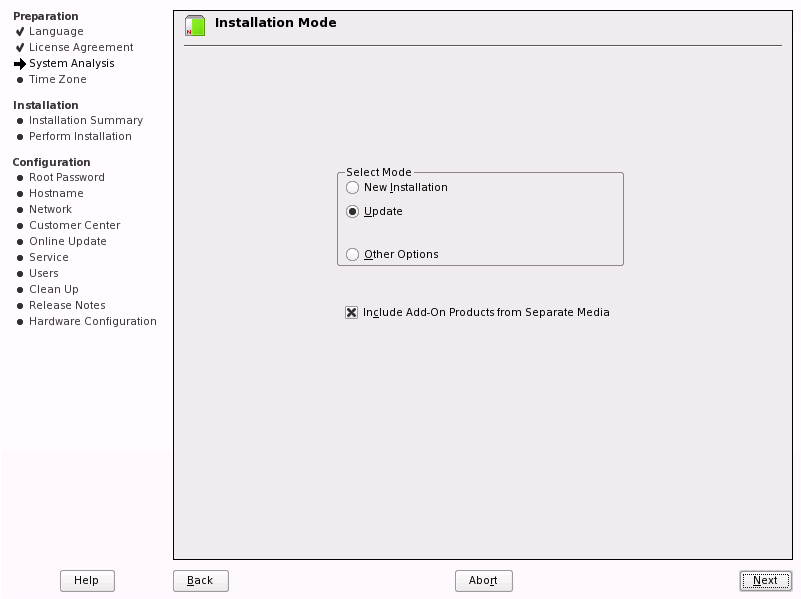
-
-
Click .
-
Continue with Specifying the Partition to Update or Specifying the Add-On Product Installation Information, depending on which matches your installation.
5.4.7 Specifying the Partition to Update
YaST tries to determine the correct root (/) partition. If there are several possibilities, or if YaST can’t definitely determine the correct root partition, the Select for Update page displays.
IMPORTANT:If no partitions are listed, you are attempting to upgrade an i386 installation using x86_64 media. Mixing architectures in an upgrade is not permitted. See Section 5.1, Supported Upgrade Paths. You must start the upgrade again, using i386 installation media.
-
If there is only one partition listed, click .
-
If there are several partitions, select the partition with /evms in the path.
For example, make sure you select the /dev/evms/lvm/... partition rather than the /dev/lvm/... partition.
-
Click .
YaST reads the old fstab on this partition to analyze and mount the file systems listed there.
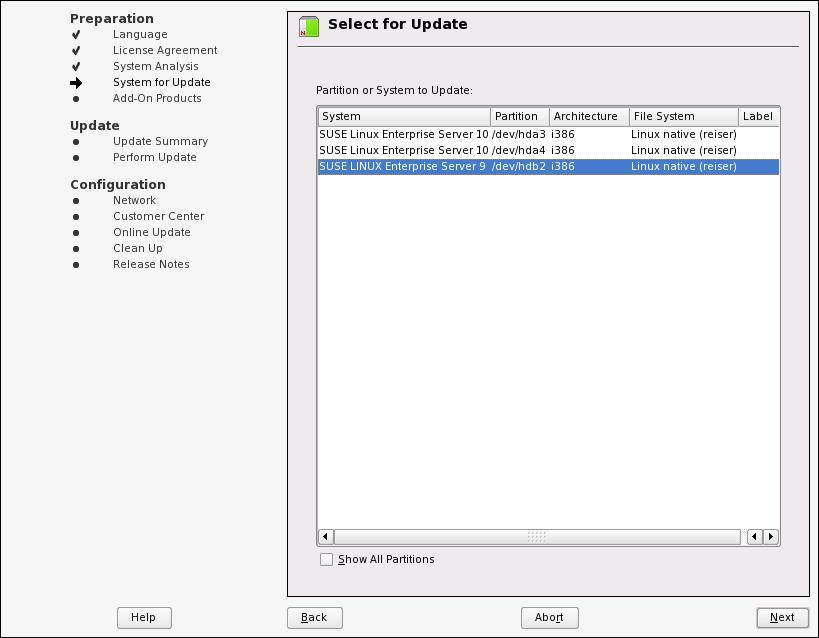
Next, YaST tries to mount the boot (/boot) partition.
-
If no error displays, skip to Specifying the Add-On Product Installation Information.
If you have EVMS on your system disk, you might get an error stating that the partition could not be mounted:
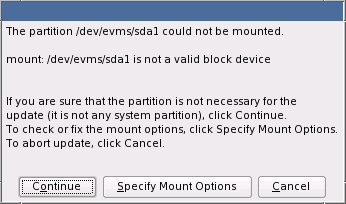
-
If this error displays, click .
The Mount Options dialog box appears.
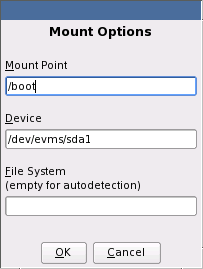
-
Remove /evms from the path.
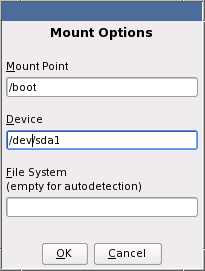
-
Click .
HINT:In rare cases, the same disks are reported as hard disk devices (hda, etc.) on SLES 9 and SCSI disk devices (sda, etc.) on SLES 10.
If you remove /evms from the device path, and you still see the error in Step 5, try changing the path to use sda instead of hda.
-
Continue with Specifying the Add-On Product Installation Information.
5.4.8 Specifying the Add-On Product Installation Information
-
When the Add-On Product Installation page displays, click .
-
In the Add-On Product Media page, if you are installing from physical media, click > . Otherwise, skip to Step 3.
-
In the Insert the Add-On Product CD dialog box, select the drive where you want to insert the CD labeled Novell Open Enterprise Server 2 SP3 CD 1 if there is more than one drive.
-
Click .
-
Insert the CD labeled Novell Open Enterprise Server 2 SP3 CD 1, click , then skip to Step 4.
-
-
If you are using an alternate installation source, such as a network location, click the appropriate option, such as the network protocol that matches your installation source, then click and specify the information for the source you have specified.
-
Read and accept the Novell Open Enterprise Server 2 license agreement, then click .
-
Confirm that the Add-On Product Installation page shows the correct path to the OES media, then click .
-
If you are upgrading from OES 1 SP2, continue with Reviewing the Delete Unmaintained Packages Notification. Otherwise, skip to Verifying and Customizing the Update Options in Installation Settings.
5.4.9 Reviewing the Delete Unmaintained Packages Notification
After the OES 2 SP3 installation source has been added, if you are upgrading from OES 1 SP2, the following notification is displayed:
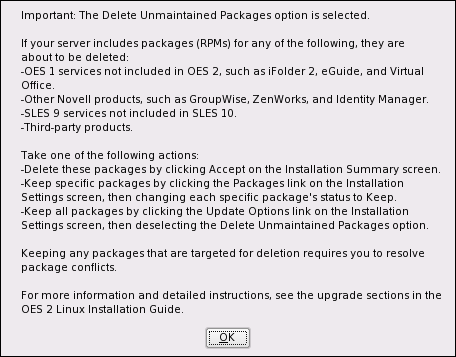
-
Carefully read the notification.
-
Decide how you want to proceed. For more information, see OES 1 Server Upgrades: Non-OES 2 Packages Are Deleted by Default.
-
Click , then continue with Verifying and Customizing the Update Options in Installation Settings.
5.4.10 Verifying and Customizing the Update Options in Installation Settings
IMPORTANT:To verify that previously installed services are selected for installation and to install any additional OES services during the upgrade, you must customize the Update Options on the Installation Settings page.
To verify or customize the software packages that are installed on the server:
-
On the Installation Settings page, make sure Novell Open Enterprise Server 2 SP3 is listed under the link. If it is, proceed with Step 3.
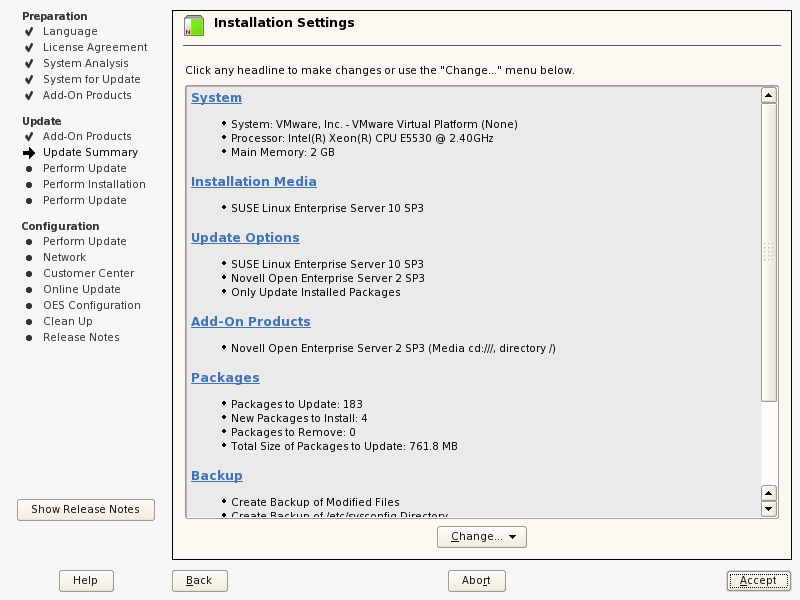
-
If Novell Open Enterprise Server is not listed, click the link and follow the steps in Specifying the Add-On Product Installation Information. When the Installation Settings page shows Novell Open Enterprise Server 2 SP3 as an installation setting, proceed with Step 3.
-
If you see package conflict errors (red text under the link), refer to the OES 2 SP3 Readme for resolution instructions.
-
On the Installation Settings page, click .
-
In the Update Options page, click >
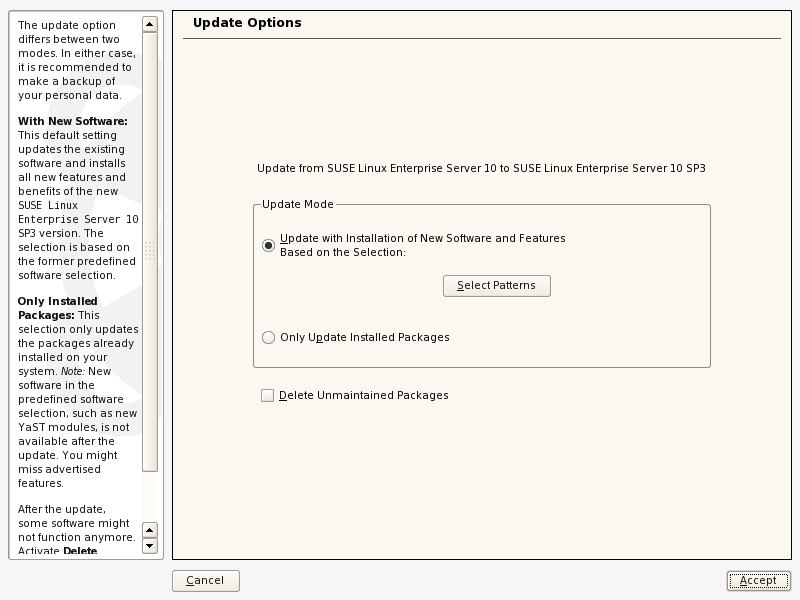
-
All of the OES Services patterns that were previously installed are selected by default.
Ensure that the patterns for the services you are upgrading are selected, and select the patterns for any new OES Services patterns that you might want to also install.
A description displays to the right of a pattern when the pattern is selected. For a description of OES Services patterns and the components selected with each pattern, see Table 2-4.
Some OES services, such as Novell CIFS and Novell Samba, are not supported together on the same server. For more information, see
Unsupported Service Combinations
in the OES 2 SP3: Planning and Implementation Guide.IMPORTANT:If you deselect a pattern after selecting it, you are instructing the installation program to not install that pattern and all of it dependent patterns. Rather than deselecting a pattern, click to cancel your software selections, then click the heading again to choose your selections again.
Selecting only the patterns that you want to install ensures that the patterns and their dependent patterns and packages are installed.
If you click , then return to software pattern selection page, the selections that you made become your base selections and must be deselected if you want to remove them from the installation proposal.
Attempting to uninstall a service by deselecting its pattern is not recommended. For more information, see Section 13.0, Disabling OES 2 Services.
Selecting a pattern automatically selects the other patterns that it depends on to complete the installation.
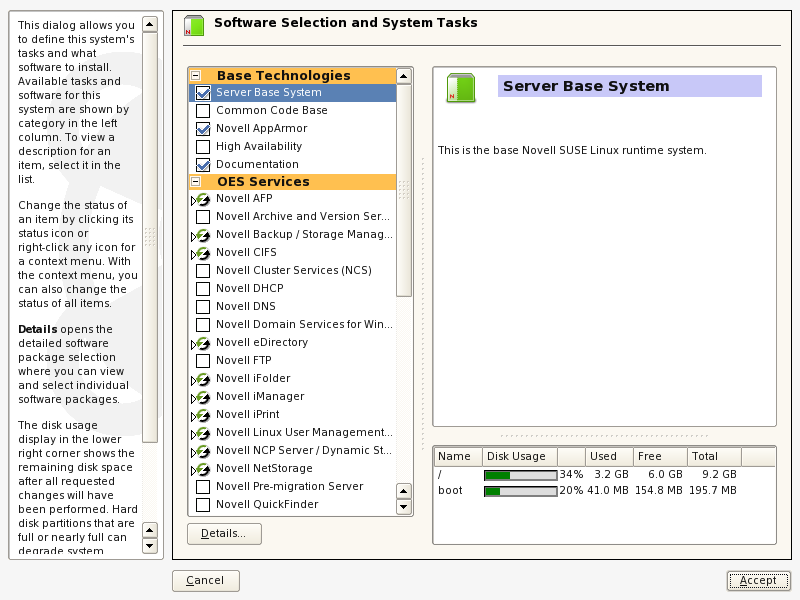
-
If you want to see the details of your selections, click .
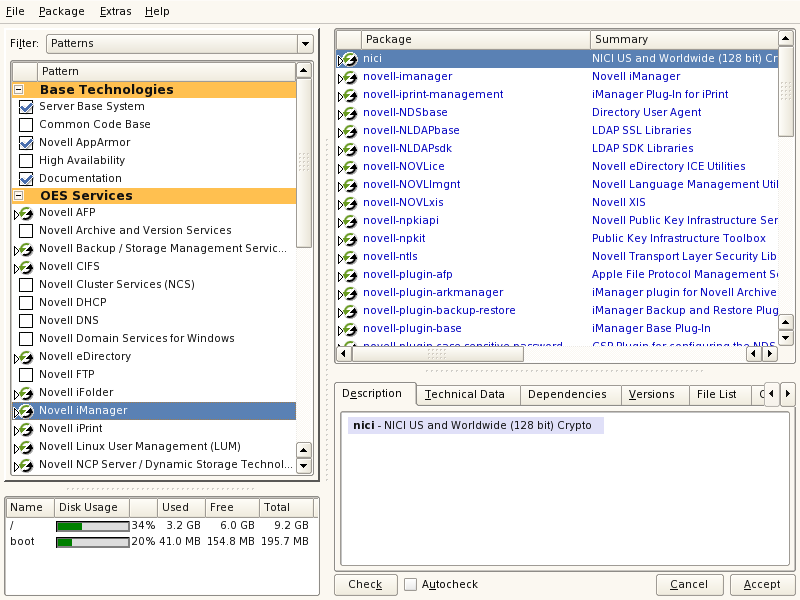
-
When you have the software components selected that you want to install, click .
-
When the notification about deleting unmaintained packages appears, click .
-
(Conditional) If the prompt for the AGFA Fonts license displays, read the agreement, then click .
-
(Conditional) If the prompt for displays, click .
-
(Conditional) If you are prompted, resolve any dependency conflicts.
-
If the Update Options page displays again, click .
-
Continue with Accepting the Installation Settings.
5.4.11 Accepting the Installation Settings
-
Review the final Installation Settings page to ensure that you have all the Installation settings you desire. Make sure that the page shows all the OES Services that you want to update and install.
-
After you have changed all the installation settings as desired, click .
-
In the Confirm Update dialog box, click .
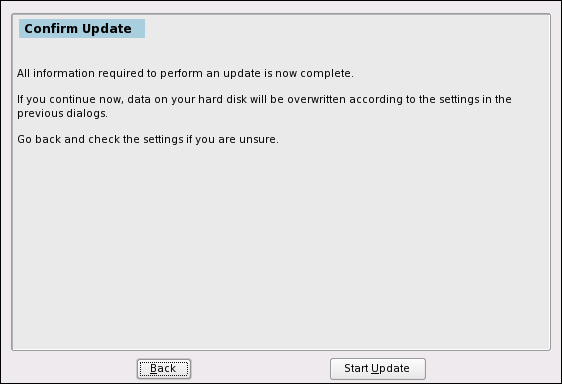
The base installation settings are applied and the packages are installed.
-
While the server is updating the files, do one of the following:
-
For installations using a network installation source, remove the boot CD (SUSE Linux Enterprise Server 10 SP4 CD 1) from the CD drive.
-
For installations using a CD or DVD installation source, leave the CD or DVD in the CD-ROM or DVD drive. When the installation process prompts you for each CD at the appropriate time, insert the CD. The progress status at the bottom of the screen indicates which CD will be prompted for next.
-
-
After the server reboots, continue with Specifying Configuration Information.
HINT:If you have the disk driver situation mentioned in Step 8, your server boots to a prompt for the root password. Specify the password, and then use an editor such as VI to modify the /etc/fstab file so that the path to the boot partition uses sda instead of hda. Then reboot the server. The upgrade should continue normally.
5.4.12 Specifying Configuration Information
When the server reboots, you are required to complete the following configuration information:
Testing the Connection to the Internet
On the Test Internet Connection page:
-
Select , , click .
-
Obtaining the latest SUSE release notes might fail at this point. If it does, view the log to verify that the network configuration is correct, then click .
-
If the network configuration is not correct, click > and fix your network configuration. See Network Interface. The most common problem is that an invalid DNS server is specified.
or
Skip this test by clicking , then continue with Step 4.
IMPORTANT:Most OES services configurations require a connection to the Internet.
Skipping this test also skips downloading release notes, configuring the Novell Customer Center, and updating online.
-
If you skipped the customer center test, continue with Upgrading eDirectory. Otherwise, continue with Specifying Novell Customer Center Configuration Settings.
Specifying Novell Customer Center Configuration Settings
To receive support and updates for your OES 2 SP3 server, you need to register it in the Novell Customer Center. When the Novell Customer Center Configuration page is displayed, you have three options:
Updating a Registered Server (Recommended)
-
If you have already registered your OES 2 server and you want to download the available patches, leave selected and click Next.
YaST contacts the server (which might take a few minutes) and then downloads the available patches.
-
Go to Step 8.
Registering the Server Later / Skipping a Registered Server Update
-
Click .
-
Continue with Upgrading eDirectory.
-
Register the server after the installation is complete by using the procedures in Section 7.3, Registering the Server in the Novell Customer Center.
Registering the Server During the Upgrade
-
On the Novell Customer Center Configuration configuration page, select all of the following options, then click .
Option
What it Does
Proceeds with registering this server and the SLES 10 SP4 and OES product in the Novell Customer Center.
Sends information to the Novell Customer Center about the hardware that you are installing SLES 10 SP4 and OES 2 on.
Sends optional information to the Novell Customer Center for your registration. For this release, this option doesn’t send any additional information.
Makes the registration with activation codes mandatory.
Keeps the installation sources for this server valid. It does not remove any installation sources that were manually added.
-
After you click , the following message is displayed. Wait until this message disappears and the Manual Interaction Required page displays.

-
On the Manual Interaction Required page, note the information that you will be required to specify, then click .
-
On the Novell Customer Center Registration page, specify the required information in the following fields:
-
Email Address: The e-mail address for your Novell Login account.
-
Confirm Email Address: The same e-mail address for your Novell Login account
-
Activation Code for SLES Components (optional): Specify your purchased or 60-day evaluation registration code for the SLES 10 product.
If you don’t specify a code, the server cannot receive any updates or patches.
-
Activation Code for OES Components (optional): Specify your purchased or 60-day evaluation registration code for the OES 2 product.
If you don’t specify a code, the server cannot receive any updates or patches.
-
System Name or Description (optional): The hostname for the system is specified by default.
If you want to change this to a description, for the Novell Customer Center, specify a description to identify this server.
-
-
Click .
-
When the message to complete the registration displays, click .

-
After you click , the following message is displayed with the Manual Interaction Required page. Wait until this message disappears and Novell Customer Center Configuration page displays with the message that Your configuration was successful.

-
When you see the message Your configuration was successful on the Novell Customer Center Configuration, click .
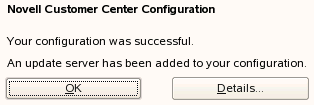
-
Continue with Updating the Server Software.
Updating the Server Software During the Upgrade
If you have a successful connection to the Internet and have registered the server in the Novell Customer Center, the server displays the Online Update page. You can run the online update now or skip it and get updates later.
To skip getting updates during the upgrade:
-
On the Online Update page, click .
-
Continue with Upgrading eDirectory.
To get updates during the upgrade:
-
On the Online Update page, click .
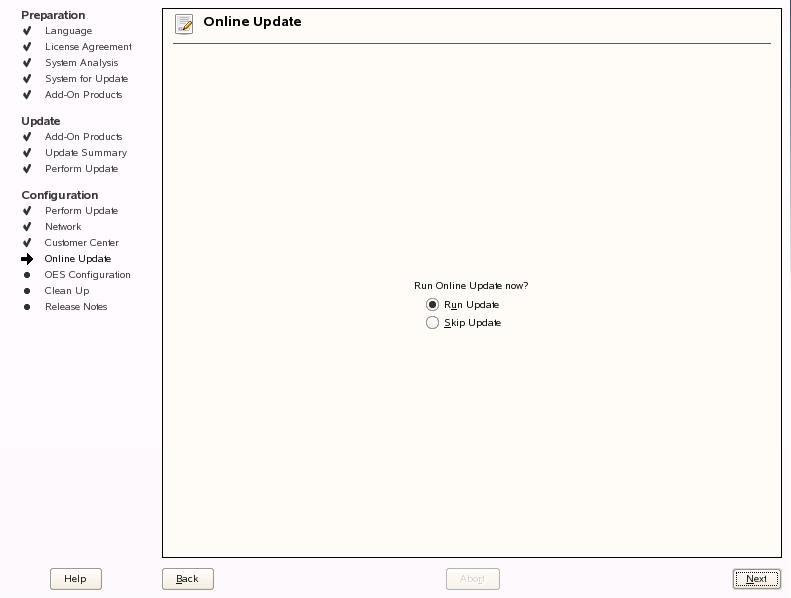
-
On the page that shows that updates are available, select the updates that you want to install, then click .
The check marks that are shown in the summary column of the patches list are the patches that have already been installed on your system.
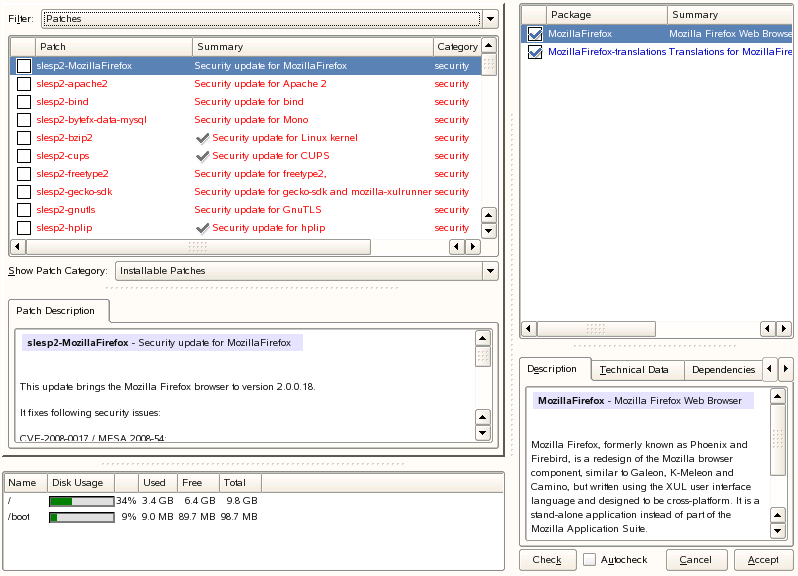
-
When you see the message, Installation finished on the Patch Download and Installation page, click .
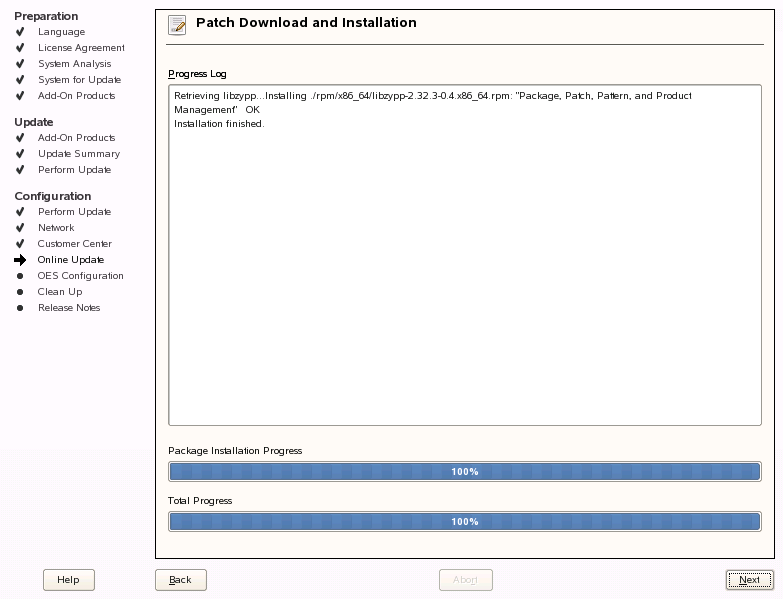
-
If the update makes changes to YaST, the following message displays. If so, click to restart YaST.

-
If the installation was interrupted, the following message might display. If so, click to continue with the installation, and enter the root password.
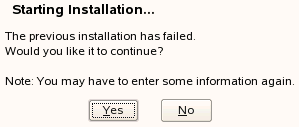
The online update displays again with additional updates. If a patch has changes to the kernel, you might want to deselect it and install it later after the installation is complete. For procedures, see Updating (Patching) an OES 2 SP3 Server.
-
If you do install patches that have changes to the kernel, click when you see the following message.
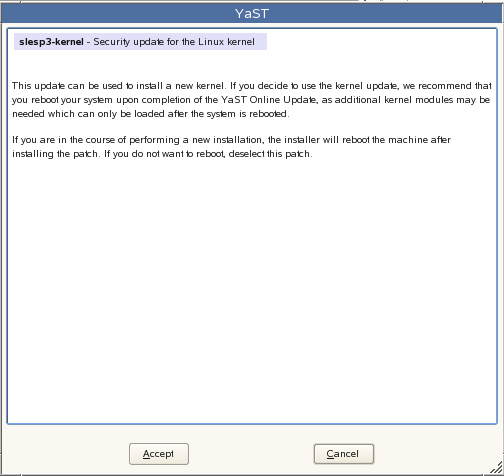
-
After all the patches are installed, continue with Upgrading eDirectory.
Upgrading eDirectory
OES 2 SP3 includes eDirectory 8.8.6.
-
When the following dialog box appears, click .

-
On the eDirectory Upgrade - Existing Server Information page, type the Admin password.
-
(Conditional) If you are upgrading from OES 1 SP2 and you have installed a third-party CA certificate on the server, consider deselecting the Use eDirectory Certificates for HTTPS services. Otherwise, your HTTPS services will be configured to use the eDirectory certificate.
For more information, see
Certificate Management
in the OES 2 SP3: Planning and Implementation Guide. -
Click .
-
On the Novell Modular Authentication Service page, click .
-
Continue with with Specifying LDAP Configuration Settings.
Specifying LDAP Configuration Settings
Many of the OES services require eDirectory. If eDirectory was not selected as a product to upgrade or install but other OES services that do require LDAP services were installed, the LDAP Configuration service displays so that you can complete the required information.
-
In the field, specify the name for the existing eDirectory tree that you are installing this server into.
-
In the field, specify the name and context for user Admin on the existing tree.
-
In the field, specify a password for user for user Admin on the existing tree.
-
Add the LDAP servers that you want the services on this server to use. The servers that you add should hold the master or a read/write replica of eDirectory. Do the following for each server you want to add.
-
When all the LDAP servers that you want to specify are listed, click .
-
Continue with Configuring Novell Open Enterprise Server Services.
Configuring Novell Open Enterprise Server Services
After you complete the LDAP configuration or eDirectory configuration, the summary page is displayed, showing all the OES components you updated and installed and their configuration settings.
-
Review the setting for each component and click the component heading to change any settings.
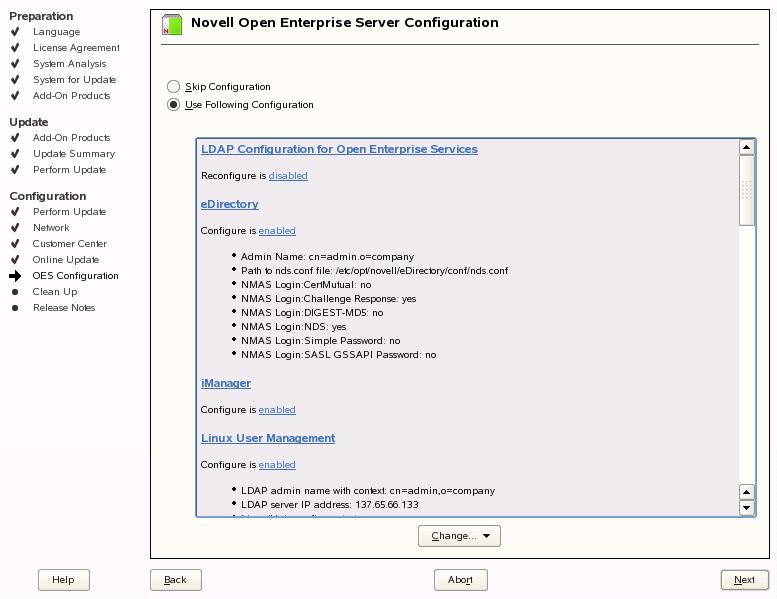
When you specify the configuration information for OES services, see the information in Configuration Guidelines for OES Services; or, if you are reading online, click a link below:
-
When you are satisfied with the settings for each component, click .
-
When you confirm the OES component configurations, you might receive the following error:
The proposal contains an error that must be resolved before continuing.
If this error is displayed, check the summary list of configured products for any messages immediately below each product heading. These messages indicate products or services that need to be configured. If you are running the YaST graphical interface, the messages are red text. If you are using the YaST text-based interface, they are not red.
For example, if you selected Linux User Management in connection with other OES products or services, you might see a message similar to the following:
Linux User Management needs to be configured before you can continue or disable the configuration.
If you see a message like this, do the following:
-
On the summary page, click the heading for the component.
-
Supply the missing information in each configuration page.
When you specify the configuration information for OES services during the upgrade, see the information in Configuration Guidelines for OES Services.
When you have finished the configuration of that component, you are returned to the Novell Open Enterprise Server Configuration summary page.
-
If you want to skip the configuration of a specific component and configure it later, click d in the status to change the status to .
If you change the status to , you must configure the OES components after the installation is complete. See Installing or Configuring OES 2 SP3 on an Existing Server.
-
-
After resolving all product configuration problems, click to proceed with the configuration of all services and installation of iManager plug-ins.
-
When the Readme page displays, click and continue with Section 5.5, Finishing the Upgrade.
